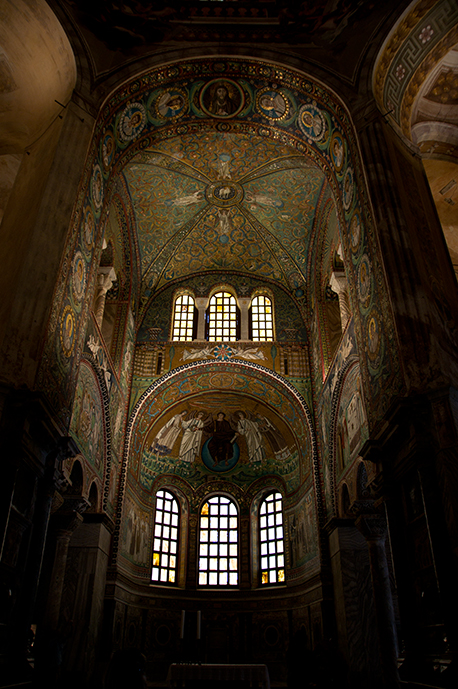Happy? Good.
The acoustic properties of the road outside my dorm room window are peculiar. Even small bikes are amplified and expanded to sound like a military procession driving past the window. God forbid a truck or bus drives past (which they do, a lot, because the bus stop is right outside the hostel). Even closing the double-glazed windows makes barely a noticeable difference.
Apparently today I am going to rant. Warning, pretension incoming.
Dear camera owners, if you are going to buy an expensive SLR camera, or even a moderately expensive bridge camera, learn to fucking use it properly. I suppose this could also apply to people with point and shoot cameras, but certainly less so. One imagines that if you spend the money and time on purchasing an SLR system then at least you should know a little about it. This is apparently not the case.
The specifics of today’s rant are brought to you from tall dark rooms, with interesting ceilings. When in Ravenna recently I visited a Basilica or tomb or cathedral or something (I was paying attention to the pretty things to take photos of, not the religious significance.) Anyway, inside was a truly beautiful ceiling with a load of artwork and painting on, but given that this was inside a huge building with no real windows or light sources, with a ceiling that was easily 15-20 metres high (quite possibly a lot more, I suck at estimating length (please, no penis jokes…)), it was quite dark inside. There were lots of tourists inside, self included, taking lots of pictures of the pretty. 99% of them (read, everyone that wasn’t me) was using their cameras with the flash to try and take pictures of the ceiling. In the words of Rincewind, “that doesn’t work.”
Let me explain, plebeians, because clearly someone needs to (reading an instruction manual is for the children). The flash range on your camera, any camera, is at maximum somewhere in the region of 16 feet, or maybe about five metres. What this means is that your flash is ineffective at lighting anything farther (further, farther?) away from your camera than that distance. At all. Oh, it’ll flash, and you’ll see a bright light on the area you’re trying to take a picture of, except it’ll make no difference to the actual picture whatsoever.
Except it will. What it’ll do, you see, is fuck it up. Because when you’re using your flash, your camera adjusts all the other settings, like exposure values etc to account for the fact that you’re flashing the scene. What this will do is cause the subject (the ceiling) to be really very dark, and the immediate foreground to be far too light. The mid-ground will just be all grey and mushy.
When confronted with low light conditions and a distant subject, turn your flash off. But, then how do I get to see the picture?! Well, by Jove, you change the other settings in your camera. Open the aperture right up to let more light in, slow the shutter speed right down to leave the shutter open for longer to let more light in, and whack the ISO range up (if you have to) to make the sensor more, well, sensitive. This will achieve results such as the following:
 Now, that’s a small version of the picture because I didn’t want to upload a full size one, but trust me, it’s pretty damn sharp, and it looks well lit, yes? Yes. To prove my point, shutter speed 1/15th of a second (slooooow), aperture f/2.8 (oooopen), ISO 1600 (hiiiigh). And yet it looks pretty damn good to me. To give you an example of how dark it was in there, here’s another shot of a different part, slightly better lit by windows and such like (taken for example’s sake):
Now, that’s a small version of the picture because I didn’t want to upload a full size one, but trust me, it’s pretty damn sharp, and it looks well lit, yes? Yes. To prove my point, shutter speed 1/15th of a second (slooooow), aperture f/2.8 (oooopen), ISO 1600 (hiiiigh). And yet it looks pretty damn good to me. To give you an example of how dark it was in there, here’s another shot of a different part, slightly better lit by windows and such like (taken for example’s sake):
 Learn to use your God damned expensive cameras, or I’ll take them off you. Here endeth the lesson.
Learn to use your God damned expensive cameras, or I’ll take them off you. Here endeth the lesson.
